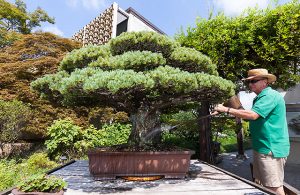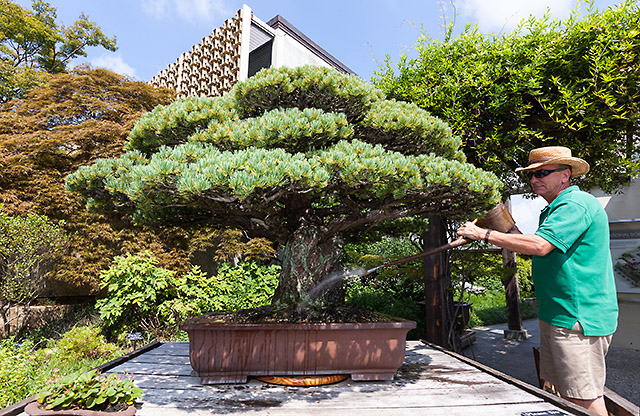By Sharon Durham, USDA Agriculture Research Service

The United States National Arboretum-National Bonsai and Penjing Museum, located in Washington, D.C.. Operated by the United States Department of Agricultures – Agricultural Research Service. Curator, Jack Sustic waters one of the museum’s special bonsai, 390 year old, Hiroshima surviving tree, donated by Bonsai master, Masaru Yamaki.
The terms “bonsai” and “penjing”—Japanese and Chinese, respectively, for “pot-cultivated”—refer to the art of designing and maintaining miniature living trees or shrubs, long considered the ultimate in gardening skill.
Japanese bonsai and its precursor, Chinese penjing, are steeped in ancient Asian traditions. Branch placement, styling, and even the choice of the pot—all these elements work in harmony to convey deep symbolism and reverence for nature.
The National Bonsai and Penjing Museum has one of the largest bonsai collections in North America. According to museum curator Jack Sustic, the collection has continued to grow steadily over the past four decades with the addition of pieces from around the world. Today, three pavilions house about 150 plants.
The Exhibits Gallery is a focal point that celebrates the related art forms of “viewing stones” (stone appreciation) and “ikebana” (Japanese flower arranging).
The Special Exhibits Wing features the work of local bonsai enthusiasts and pieces from the permanent collection with special seasonal features.
A historically significant point in U.S.-Japanese relations is commemorated by a special bonsai in the collection: a 390-year-old specimen from Japan that survived the atomic bombing of Hiroshima. The tree, donated by bonsai master Masaru Yamaki, was part of the 53-specimen gift to the United States for its Bicentennial.
The collection also features the most famous bonsai in the world, Goshin, created by Japanese-American bonsai master John Naka. Japanese for “protector of the spirit,” Goshin is a forest planting of 11 junipers representing Naka’s 11 grandchildren at the time the bonsai was created.
Read more about the exhibit in the October issue of AgResearch.










